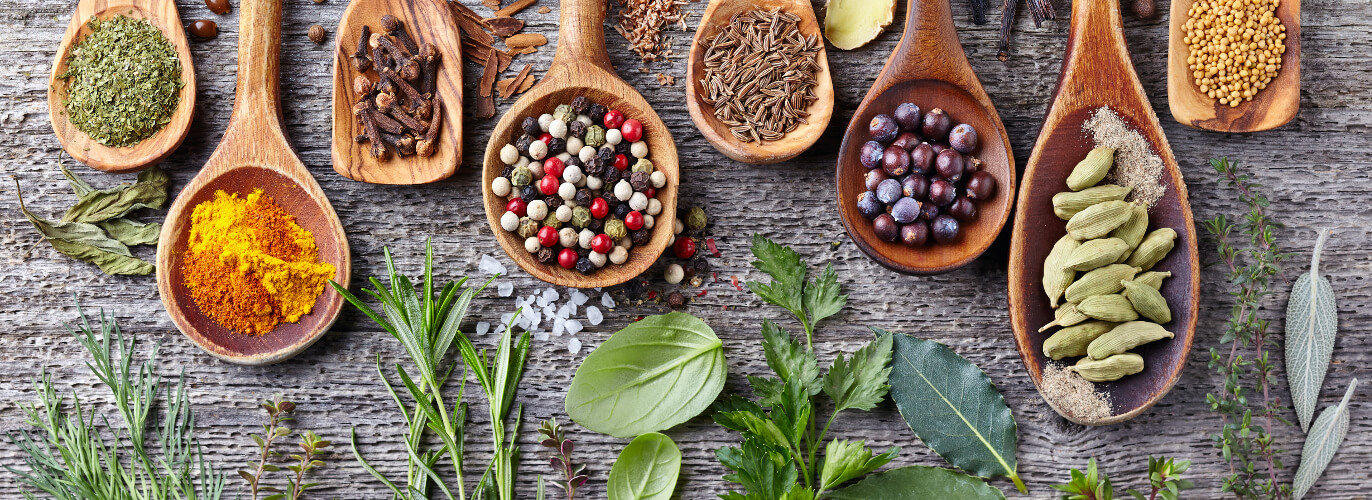List of Common Cooking Herbs & Spices
Spices, Herbs & Seasonings have a very long history of aromatic, preservative, and healing effects. Spices originated from the Latin phrase “species aromatacea”, which translate to “fruits of the earth” later becoming a commodity that was traded in early commercial trade. Let’s get into a bit more about where herbs, spices, and seasonings come from and what they’re good for when it comes to cooking. Here's our list of Top 3 Herbs & Spices that you should have in your kitchen and our list of Spice Rack essentials in the pre-made grocery list template below. Enjoy!
Common Cooking Herbs
With a variety of uses, herbs have place both in medicine and in the culinary world. In some cultures, herbs are used for healing in their various forms for an array of illnesses. Their place in the culinary world is to add flavoring, similar to spices and seasonings. Some of the most common cooking herbs are uses as garnishes or are mixed in to add aromas and flavoring. Herbs are annual, biennial or perennial, which indicates how long they take to grow. Annual herbs take one year, Biennial herbs take two years to grow, and perennial takes more than two years to grow.
Most common cooking herbs and their popular uses:
Parsley
What is Parsley?
Among the most common of herbs, Parsley is native to the Mediterranean. Parsley takes two years to grow and is widely used in western cultures for cooking as a garnish (served on top of the final dish). Parsley is very rich in vitamins, minerals, and antioxidants.
What Should I Cook With Parsley?
Often chopped fresh, parsley is used as a garnish and is sprinkled on top of dishes from many cultures. In some European cultures, parsley is commonly bundled with other spices and mixed into sauces and soups. It is also used commonly in sandwiches and among other greens in salad.
Read Our Mediterranean Diet Grocery List Here
Coriander (Cilantro)
What is Cilantro?
“Cilantro” is Spanish for “coriander”, which is among the most popular of herbs in use today. Coriander is an annual herb, which means it take one year to grow, and is native to Western Asia and parts of Europe.
What Should I Cook With Coriander?
Coriander comes in seed form, which is often ground fresh and used in a variety of recipes for how it impacts flavor with tartness and aromatic effects. Coriander is used across cultures in curry dishes in India to flavoring rye bread in Russia to pickling vegetables in German and South African cultures to giving Belgian Witbier its citrusy character. Coriander literally and figuratively unites us in the name of citrusy, tart, lemony goodness.
Read Our International Brunch Ideas & Grocery List Here
Thyme
What is Thyme?
Not one of the most popular songs by Pink Floyd, but rather one of the most popular herbs in western (American & European) dishes. Thyme is a perennial plant, which takes two or more years to grow, and is used in both fresh and dry forms. Thyme is minty in character
What Should I Cook With Thyme?
There’s a number of foods that thyme is good for flavoring. Most well known are for meats, as well as soups and even vegetables, legumes, and cheeses.
Read our Chicken Marinade Recipe Ideas & Shopping List Here
Most common cooking spices and popular uses:
Black Pepper
What’s Black Pepper?
Coming from the peppercorns of the pepper plant, Black Pepper is one of the most common spices for cooking in Western cultures, despite being confused as a seasoning. Black Pepper is native to Southeast Asia and is most exported from this region. This plant has been used for both cooking and for medicinal purposes. It is also very rich in the not-so-often mentioned Vitamin K, which helps support blood clotting and bone health.
What Do I Cook With Black Pepper?
Black Pepper is most known for its heat and gets that head from the out fruit and the seed of the peppercorn. Subtle health benefits are seen in Black Pepper due to its spiciness and how that affects digestion. Black Pepper comes most commonly in crushed form going well with meats like Steak, Chicken Breast. Dishes like soups, stews and home-made salad dressing. Remember that Black Pepper in crushed form required an air-tight environment to hold well in!
Ginger
What is Ginger, Exactly?
Ginger is perennial plant, which means it takes up to one year or more to grow. The Ginger Plant is an herb in which the stem of it is grown underground – this is called a rhizome. The Ginger Root is a rhizome and is what we buy in the grocery store. Ginger is not only known for its application to recipes all over the world, but also for its medicinal effects, specifically for anti-inflammatory effects and for treating nausea.
What Do I Cook With Ginger?
Ginger is extremely versatile. Many Eastern cultures use ginger commonly in their dishes, while it can be found in all types recipes from baked goods like gingerbread to sauces like honey-ginger barbecue sauce to drinks like ginger herbal tea, ginger beer, and ginger ale. Ginger is an essential spice to have in your kitchen for many occasions and recipes.
Cumin
What is Cumin, Exactly?
Cumin is a plant native to the Mediterranean and South Asia in which the seeds are cultivated and dried and used in various recipes and for traditional medicine purposes. Cumin is among some of the oldest spices known to civilization, as it was used by Egyptian cultures as a spice and for preservation. It is used in Persian cuisine in various forms, most notably green and black cumin.
What Do I Cook With Cumin?
Cumin is very lends flavorful and aromatic character to food around the world. Cumin is found in both ground and seed forms giving food an earthy taste and a bit of a warming sensation to the food it’s cooked in. It’s found in various breads and cheeses from France, it’s combined as a spice into various seasonings and is often added to various stews, soups, sauces, and gravies.
Herb & Spice Essential Grocery List
Use this checklist of the most essential herbs and spices to have in your pantry.
- Salt
- Black Pepper
- Cinnamon
- Basil
- Parsley
- Thyme
- Rosemary
- Cumin
- Coriander
- Paprika
- Oregano
- Cumin
- Bay Leaves
- Cayenne
- Chives
- Tumeric
- Dill
- Red Pepper Flakes
- Curry Powder



.jpg)



